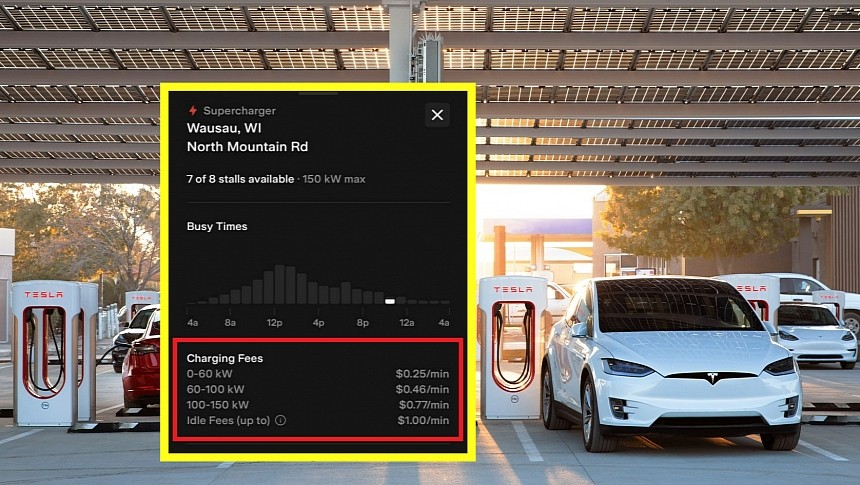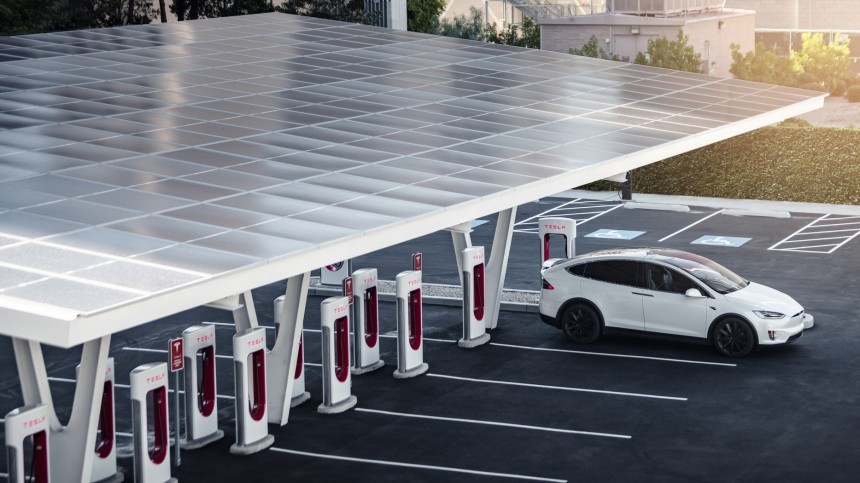A Model X Long Range owner discovered that Tesla charges American users who plug into its high-power network differently in pay-by-the-minute states. But the world's most valuable company had to apply this three-tier pricing strategy. Here's why.
A person bought a used 2020 Model X Long Range directly from Tesla because they wanted more cabin room and considered that they were ready to make the household an all-electric one. They first tested the EV lifestyle with a 2017 Model X. That unit is still with their family at the time of writing. But before jumping into the zero-tailpipe emission world, this person owned a Toyota Prius. And that's the catalyst that led to fast-charging dissatisfaction.
While on a trip to the Upper Midwest, they discovered that Supercharging is not cheap in states where pricing is set per minute. They opened the app and saw that costs ranged from $0.25 to $0.77 per minute.
The person did the math and figured out that driving 200 miles in a Prius would cost them around $16, whereas Supercharging left them with a $27.60 bill. That's over $11 more for not polluting the local environment and enjoying the perks of owning an arguably luxurious EV with cool rear doors.
But they were wrong.
Previously, Tesla buyers living in states where the automaker was told it could not sell electricity but only the charging service paid much less than Americans located in pay-by-the-kWh states. That led to some friction among customers who envied those with per-minute charging. They were paying around half of what the other Tesla owners got charged for the same service.
But as Tesla kept investing in the Supercharger network, they had to even out pricing at a federal level. Introducing the V3 Supercharger meant EV owners could charge at a maximum speed of 250 kW per hour. V2s were only capable of dispensing energy at a rate of 150 kW.
It introduced tiered pricing in per-minute states to make things right and add to the Supercharger revenue. That leveled out the field for fast charging. But it nearly doubled the prices for those living in places like Wisconsin.
Even though this move happened two years ago, some still believe that the world's most valuable automaker favors Americans living in states where the rules say the company can't sell electricity.
Fortunately, that's not the case. Everyone's treated almost equally when paying for plugging into the auto brand's DC fast chargers. It used to happen, but not anymore. That's great news for anyone who is planning on acquiring an EV.
The app screenshot also shows a maximum price of $0.77 per minute because there's no 250-kW stall available at that Supercharger location in Wausau, Wisconsin. The cost could have been even higher at a V3 stall - $1.1 per minute!
But on top of all this, this person compared their all-electric 5,100-lb SUV with an economical hybrid sedan. Moreover, they only accounted for four gallons of fuel while they charged the Model X's battery to 98% at a Supercharger. That is not recommended for trips with more Tesla-branded stations along the route. Plugging in for 15-20 minutes at a V3 stall should be enough for around 200 miles of range. Waiting to replenish the battery over the 80% threshold takes more time. It's not even recommended to constantly aim for over 80% charging sessions.
Charging at home is highly recommended for commuting or shorter trips, which this person does and says it costs them $0.03 per kWh if they plug in between 12 AM and 6 AM. That's a lot better than what someone driving a BMW X5 would spend on fuel to go from home to work and back.
In the end, we should remember that Supercharging is a service that costs more simply because it enables EV owners to replenish their batteries faster and is conveniently available in most parts of North America.
While on a trip to the Upper Midwest, they discovered that Supercharging is not cheap in states where pricing is set per minute. They opened the app and saw that costs ranged from $0.25 to $0.77 per minute.
The person did the math and figured out that driving 200 miles in a Prius would cost them around $16, whereas Supercharging left them with a $27.60 bill. That's over $11 more for not polluting the local environment and enjoying the perks of owning an arguably luxurious EV with cool rear doors.
But they were wrong.
Previously, Tesla buyers living in states where the automaker was told it could not sell electricity but only the charging service paid much less than Americans located in pay-by-the-kWh states. That led to some friction among customers who envied those with per-minute charging. They were paying around half of what the other Tesla owners got charged for the same service.
But as Tesla kept investing in the Supercharger network, they had to even out pricing at a federal level. Introducing the V3 Supercharger meant EV owners could charge at a maximum speed of 250 kW per hour. V2s were only capable of dispensing energy at a rate of 150 kW.
It introduced tiered pricing in per-minute states to make things right and add to the Supercharger revenue. That leveled out the field for fast charging. But it nearly doubled the prices for those living in places like Wisconsin.
Fortunately, that's not the case. Everyone's treated almost equally when paying for plugging into the auto brand's DC fast chargers. It used to happen, but not anymore. That's great news for anyone who is planning on acquiring an EV.
The app screenshot also shows a maximum price of $0.77 per minute because there's no 250-kW stall available at that Supercharger location in Wausau, Wisconsin. The cost could have been even higher at a V3 stall - $1.1 per minute!
But on top of all this, this person compared their all-electric 5,100-lb SUV with an economical hybrid sedan. Moreover, they only accounted for four gallons of fuel while they charged the Model X's battery to 98% at a Supercharger. That is not recommended for trips with more Tesla-branded stations along the route. Plugging in for 15-20 minutes at a V3 stall should be enough for around 200 miles of range. Waiting to replenish the battery over the 80% threshold takes more time. It's not even recommended to constantly aim for over 80% charging sessions.
Charging at home is highly recommended for commuting or shorter trips, which this person does and says it costs them $0.03 per kWh if they plug in between 12 AM and 6 AM. That's a lot better than what someone driving a BMW X5 would spend on fuel to go from home to work and back.
In the end, we should remember that Supercharging is a service that costs more simply because it enables EV owners to replenish their batteries faster and is conveniently available in most parts of North America.























